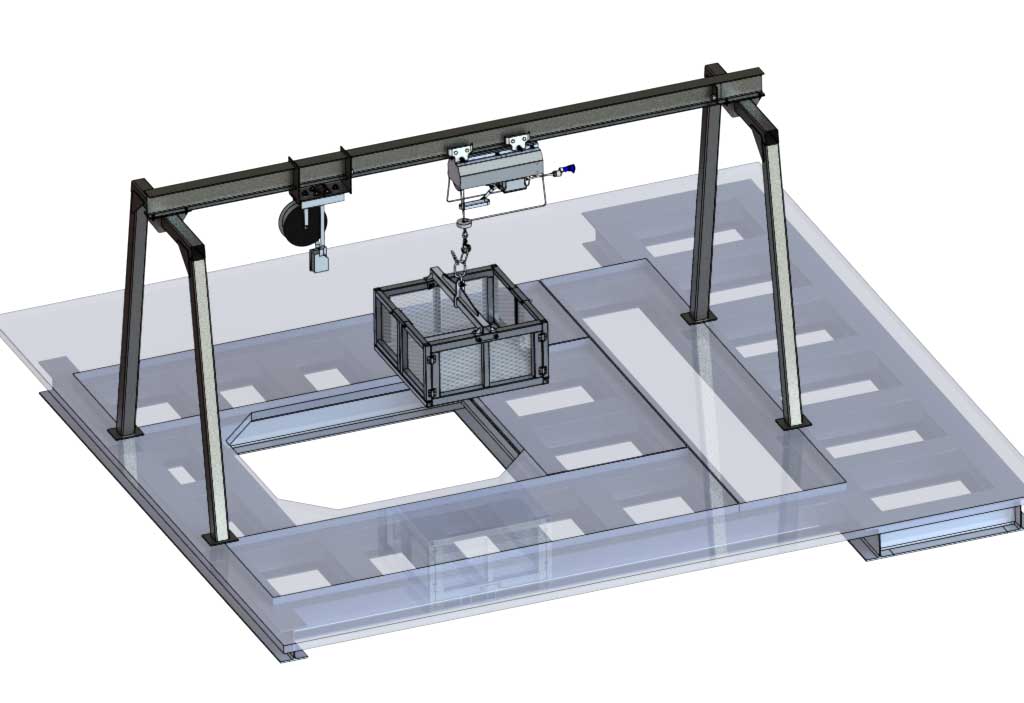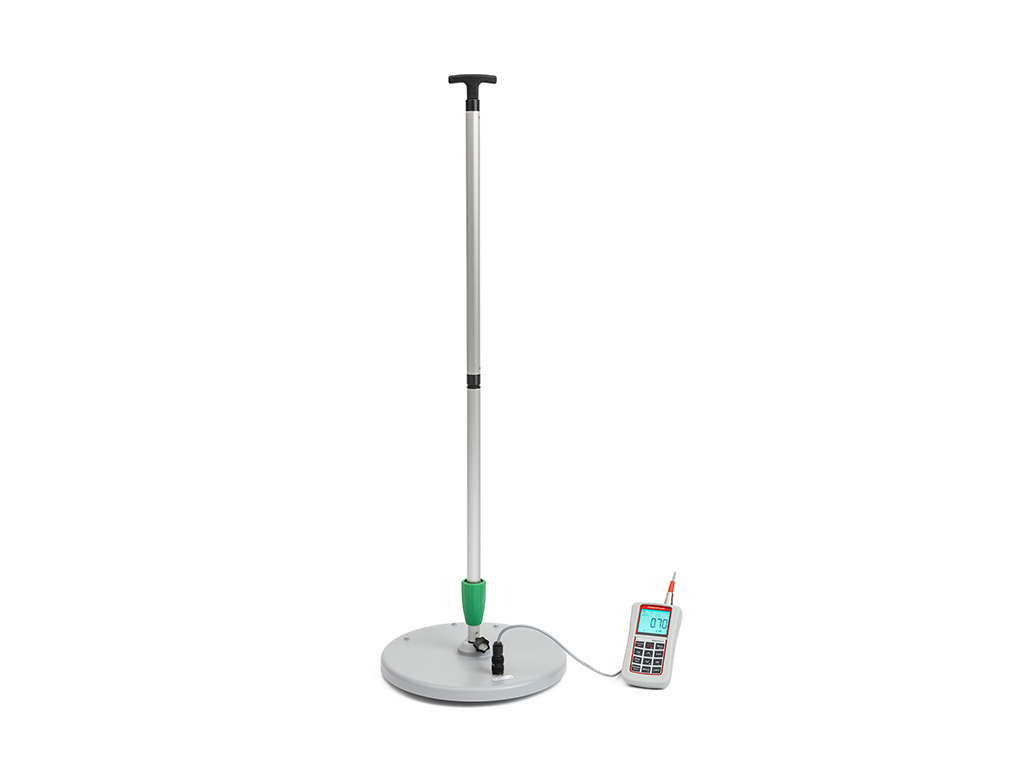A unique solutions to refractory maintenance on a vertical kiln, borrowing an example for the sugar industry.
GOING VERTICAL: Bricking Solutions of Monroe WA USA has been supplying refractory installation equipment to the cement, lime and other process industries for over 40 years. Until just recently their equipment has been designed primarily for horizontal kilns or furnaces. The only venture into vertical vessels was to supply high strength aluminum support beams and beam installation systems used to build scaffold support floors in cement preheat tower cyclones.Amalgamated Sugar in Paul, Idaho USA recently installed a new Eberhardt Lime Shaft Kiln KR8.0. JT Thorpe & Son, Inc installed the six component brick lining using staging in conjunction with a construction elevator and internal hoist. Once the brick was installed and kiln operational, Amalgamated Sugar needed a way to occasionally inspect and repair the refractory. The only method available for them to inspect and repair the brick is a complex scaffolding system. Previously it took Amalgamated Sugar at least 2 full days and a complete crew to set up the scaffolding for their 97’ tall lime kiln. Another obstacle is there is only one entry point into the kiln 80 feet from grade which means all items need to be lifted by a crane and be able to fit through the 54” height by 36” wide entry point.
This installation method is not only costly because of labor hours but also shuts the kiln down much longer for inspection and patchwork. Vertical lime kilns are the second most popular kilns aside from the rotary kiln in the United States and Amalgamated Sugar knew there had to be a better way to move up and down their kiln. Working with Amalgamated Sugar, Bricking Solutions came up with a custom design that greatly decreases the kiln down time that safe and efficient.
Bricking Solutions is a world class aluminum fabricator and uses high strength, light weight 6061 T6 aluminum in their products. They are best known for their “Ez Flexx” Bricking Machine and Kiln Access Ramps. Bricking Solutions design engineers utilized this expertise in aluminum fabrication to design a light weight 22 foot in diameter suspended aluminum work platform with a net load capacity of 6000 lb. (2722 kilos). The platform is suspended by 6 Safeworks LLC “Spider SC-1500” 1500lb capacity hoist. Hoists can be purchased or rented and it is recommended that an additional spare hoist as backup be available to prevent down time in the case of a hoist failure. Amalgamated Sugar chose to rent rather than purchase the hoists; in addition, 12 5/16” steel rope cables were also rented. Two cables for each hoist are required and should be long enough to run from the anchor shackle down to the floor of vessel. The redundant brake cables must be weighted with at least 25 lb in order to run through the hoist. Safeworks LLC also recommends that the cables be replaced after each use to prevent cable failure.
PUTTING PLANS INTO ACTION: The suspended platform was shipped the end of February 2013 and commissioned the end of May (28th and 29th). Bricking Solutions provided a 5 person commissioning team including two Bricking Solutions certified design engineers, BBS Technical Services manager, Bricking Solutions Production Manager and Mark Keller of Trident Industrial Services Inc. (A Corrosion & Refractory Consulting Services Company).
Before the new suspended platform can be installed, Amalgamated Sugar fills the kiln with cold Lime stone to gradually cool the kiln to prevent the shell from warping. With only one entry point into the kiln 80 feet from grade, after the kiln has cooled, the lime stone was then removed to just below the entry point to form a “basement” to allow the assembly of the platform. Since this is a new method of installation, Stainless steel rigging anchors were welded to vessel wall above the heat shield at the top of the vessel. One of Bricking Solutions engineers surveyed the vessel wall and determined it would be sufficient support for the 6,000 lb capacity suspended platform.
While the rigging anchors were being installed, the platform frame sub-components were hoisted to the 80 foot access level and manually passed into the kiln through the man access door. Since the only access is one door 54” height by 36” wide, Bricking Solutions needed to design all components to be able to fit through this small opening and the components needed to be modular. The frame was assembled on the floor, the six hoists were connected to the frame and the cables were installed.
 Once the frame was completed and the hoists operational, the suspended platform was lifted a few feet off the floor to be able to easily install the decking. An opening in the center of the platform allows workers to stand in the middle and the decking can be laid on top of the frames. After all the decking, excluding the middle section, is installed, the suspended platform was raised to a little over head height from the basement stone and final fasteners were installed. It is important to note that all connections were made by pin connectors except the connection of the “Spider Hoist” to the frame.
Once the frame was completed and the hoists operational, the suspended platform was lifted a few feet off the floor to be able to easily install the decking. An opening in the center of the platform allows workers to stand in the middle and the decking can be laid on top of the frames. After all the decking, excluding the middle section, is installed, the suspended platform was raised to a little over head height from the basement stone and final fasteners were installed. It is important to note that all connections were made by pin connectors except the connection of the “Spider Hoist” to the frame.
Once the suspended platform was completed, final electrical connections to the special control box designed by Bricking Solutions were made. The control box allows all six hoists to be run by one operator. After all the cables (including extra safety brake cables) and electrical connections were made, the suspended platform was successfully tested by running it up and down the kiln with a total of 9 people wearing safety harnesses with lanyards. Surveying and welding the rigging anchors is a onetime installation and will be used with each operation of the suspended platform. Excluding this time spent and the electrical connections, the total set up took about two hours with a 10 person crew.
SAFETY FIRST: Notable features of the suspended platform are its light weight yet strong aluminum components, modular construction with mostly pin connectors for easy handling and transportation through access constraints. The six Safeworks LLC hoists that raise and lower at 35ft per minute and exclusive lever operated preloaded guide wheels. With the suspended platform, inspections are more thorough giving the inspector 360 degree access at any given height. Whereas with other means such as a Manbasket or Bosun Chair that have to be moved from anchor point to anchor point around the circumference of the vessel which is very time consuming. The distance between these anchor points are not easily accessed and thus overlooked and not inspected. Because of this, compromised areas of the refractory lining are missed and go undetected which may cause lining failure and very costly repairs and lost production costs. Even Scaffolding tends to inhibit proper inspection due to the fact that the inherent design of the scaffold places the Standards (Uprights) and the Ledgers (horizontal pipes) too close to the wall of the vessel. The octagonal design of the scaffold structure also causes the inspector to have to reach out at the midpoint of the Ledger (horizontal pipe) section to be able to inspect the vessel wall.
The platform is the safest option over all other methods for repairs as well. The Manbasket and Bosun Chair options are only effective for very tight areas such as small diameter stacks and only useful for very small repairs in any circumstance regardless of diameter. Scaffolding used for repairs usually entails manually handling materials (Bricks, Tiles and Mortar) from landing to landing up the scaffold. This opens up the risk of materials being dropped and skeletal/muscular injuries to workers from repetitive handling and reaching out to place the new materials. The suspended platform allows the workers to be able to constantly work at an ideal and comfortable height with an unobstructed 360 degree access to the work area. The suspended platform with its “elevator” like operation also allows the entire crew to ride the platform up and down for work breaks which is quicker and eliminates the potential of Slips, Trips and Falls that navigating scaffold ladders and stairs have. Also the suspended platform can be pre-loaded with materials before lifted into position at the working height. This also increases efficiency and decreases the time to get the required materials to the work height.
In addition, the lever operated preloaded guide wheels provide stability to the suspended platform (generically called “Swing Stages” by the industry) when engaged and are able to retract to allow the suspended platform to navigate past any obstructions on the kiln interior surface, such as distortions, anchors or instruments.
Bricking Solutions next challenge for the suspended platform will be a larger platform with a load capacity of approximately 10,000 lbs. (4500 kilos) with an open center to allow material to be supplied by a separate material basket. The platform will have to be adjustable to different diameters. Bricking Solutions hopes to apply this suspended platform concept to preheat tower cyclones in the Cement Industry.
Contact us here to learn more!















